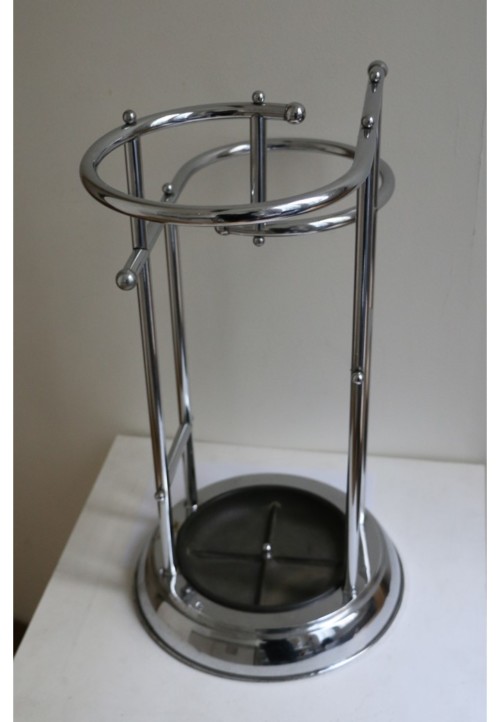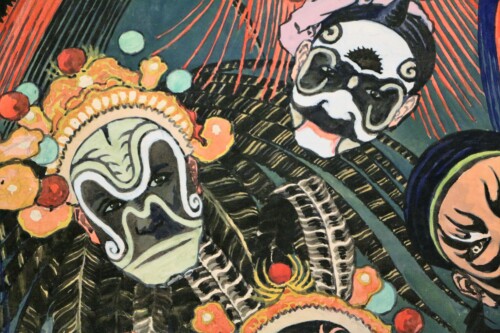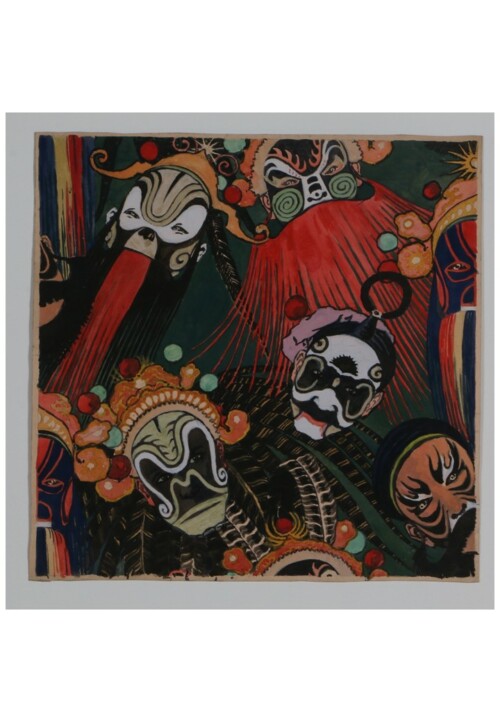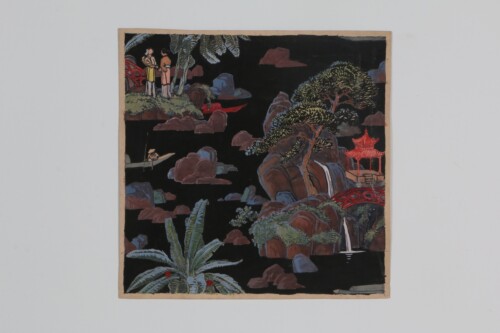-
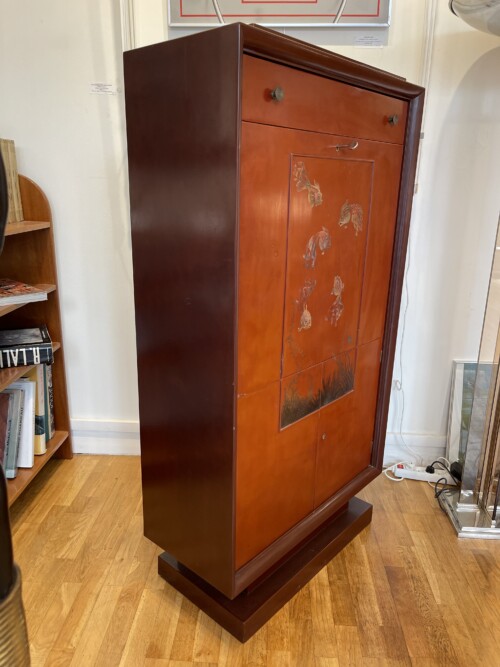
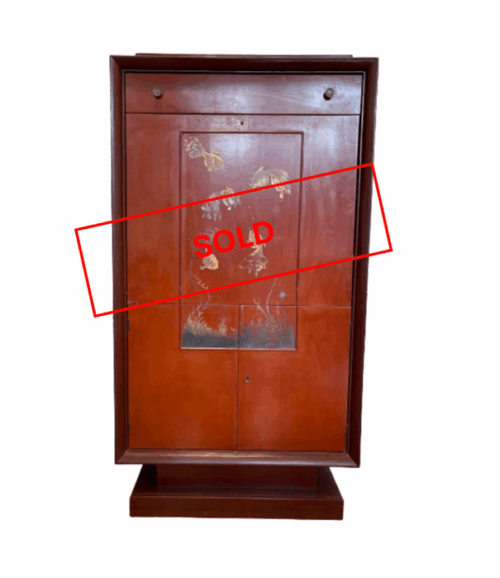 Secrétaire de période art déco en laque prune (bâti et base) et corail (façade). Le corps est quadrangulaire sur une base Piédestal. La façade inférieure s’ouvre par deux vantaux, surmontée d’un battant et d’un tiroir, circa 1950. Le décor principal est au centre du corps, il est composé de poissons japonais en laque et feuilles d’or. L’abattant découvre un sous-main gainé de parchemin et un intérieur organisé de tiroirs et en niches. Signé Pierre DUNAND et marqué M. GENU-DELATTRE, en bas à droite du décor principal. Très bon état général, traces, usures et rayures cohérentes avec l'âge du meuble, quelques taches à la laque. H : 148cm L : 80cm P : 36cm Pierre DUNAND (1914-1996) se mit à travailler à l’atelier de son père, Jean DUNAND (1877-1942), à ses 17 ans. Il se spécialisa par la suite dans la laque auprès des artisans employés par son père. Il travailla toute sa vie dans l’atelier paternel, qu’il reprit après son décès. Secretary in lacquer, Pierre DUNAND (1914-1996) circa 1950 Art deco period secretary in plum lacquer (frame and base) and coral (facade). The body is quadrangular on a pedestal base. The lower façade opens with two leaves, surmounted by a leaf and a drawer, circa 1950. The main decoration is in the center of the body, it is composed of Japanese fish in lacquer and gold leaf. The flap discovers a parchment-wrapped underhand and an organized interior of drawers and niches. Signed Pierre DUNAND and marked M. GENU-DELATTRE, bottom right of the main decor. Very good general condition, traces, wear and scratches consistent with the age of the furniture, some stains to the lacquer. H:58.27 inches W: 31.5 inches D: 14.18 inches Pierre DUNAND (1914-1996) began working in his father’s workshop, Jean DUNAND (1877-1942), at the age of 17. He later specialized in lacquer with the craftsmen employed by his father. He worked all his life in the paternal workshop, which he resumed after his death.
Secrétaire de période art déco en laque prune (bâti et base) et corail (façade). Le corps est quadrangulaire sur une base Piédestal. La façade inférieure s’ouvre par deux vantaux, surmontée d’un battant et d’un tiroir, circa 1950. Le décor principal est au centre du corps, il est composé de poissons japonais en laque et feuilles d’or. L’abattant découvre un sous-main gainé de parchemin et un intérieur organisé de tiroirs et en niches. Signé Pierre DUNAND et marqué M. GENU-DELATTRE, en bas à droite du décor principal. Très bon état général, traces, usures et rayures cohérentes avec l'âge du meuble, quelques taches à la laque. H : 148cm L : 80cm P : 36cm Pierre DUNAND (1914-1996) se mit à travailler à l’atelier de son père, Jean DUNAND (1877-1942), à ses 17 ans. Il se spécialisa par la suite dans la laque auprès des artisans employés par son père. Il travailla toute sa vie dans l’atelier paternel, qu’il reprit après son décès. Secretary in lacquer, Pierre DUNAND (1914-1996) circa 1950 Art deco period secretary in plum lacquer (frame and base) and coral (facade). The body is quadrangular on a pedestal base. The lower façade opens with two leaves, surmounted by a leaf and a drawer, circa 1950. The main decoration is in the center of the body, it is composed of Japanese fish in lacquer and gold leaf. The flap discovers a parchment-wrapped underhand and an organized interior of drawers and niches. Signed Pierre DUNAND and marked M. GENU-DELATTRE, bottom right of the main decor. Very good general condition, traces, wear and scratches consistent with the age of the furniture, some stains to the lacquer. H:58.27 inches W: 31.5 inches D: 14.18 inches Pierre DUNAND (1914-1996) began working in his father’s workshop, Jean DUNAND (1877-1942), at the age of 17. He later specialized in lacquer with the craftsmen employed by his father. He worked all his life in the paternal workshop, which he resumed after his death. -
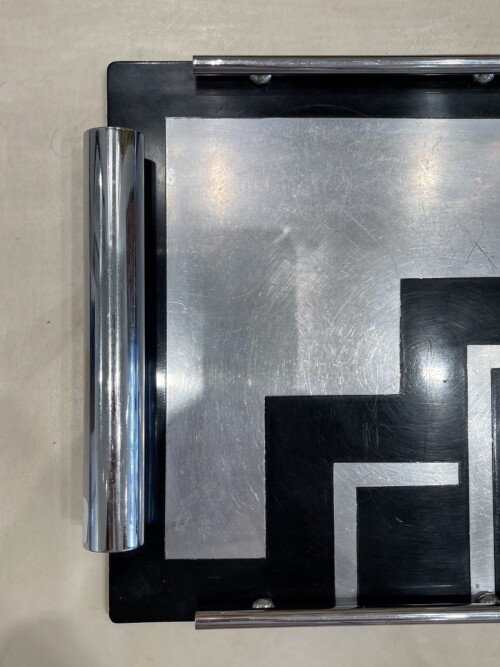
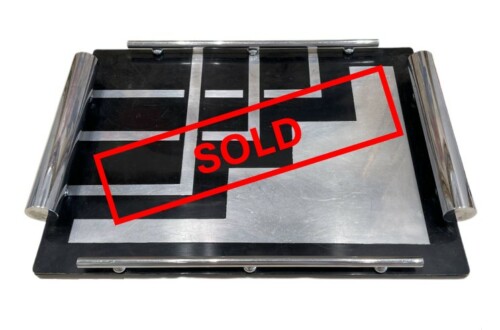 Ce plateau rectangulaire daté des années 1930 est typique du Bauhaus. Sa composition est marquée par une asymétrie du décor comprenant cependant des motifs géométriques réguliers, des lignes pures et un détachement face à l'ornement caractéristique du goût du Bauhaus.
Ce plateau rectangulaire daté des années 1930 est typique du Bauhaus. Sa composition est marquée par une asymétrie du décor comprenant cependant des motifs géométriques réguliers, des lignes pures et un détachement face à l'ornement caractéristique du goût du Bauhaus.- Le plateau est en bois laqué noir incrusté de lames d'aluminium et les prises sont en métal chromé. Il présente quelques piqures, rayures et sauts de laque.
This rectangular tray, dating from the 1930s, is typical of the Bauhaus. Its composition is marked by an asymmetry in the design, yet it features regular geometric patterns, clean lines, and a detachment from ornamentation, characteristic of Bauhaus aesthetics.- The tray is made of black lacquered wood, inlaid with aluminium strips and the handles are made in chromed metal. It shows some minor pittings and scratches.
-
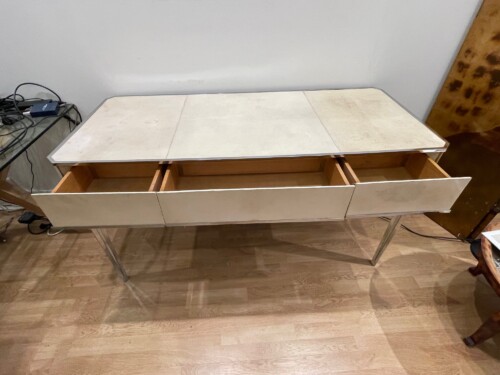
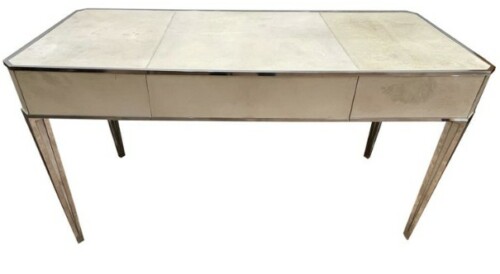 Superbe secrétaire Art Deco Primavera, fait d'une structure en bois de hêtre. Toutes les faces sont entièrement recouvertes d'un parchemin de cuir. Tous les angles sont renforcés par du métal chromé. Trois grands tiroirs occupent l'entièreté de la hauteur et de la profondeur du bureau, chacun disposant d'une séparation au milieu. Fait en France, dans les années 1930. Dimensions : L 141cm, l 61 cm, hauteur de 75cm. Pour plus d'informations sur Primavera, cliquez ici Superb Art Deco desk/secretaire by Primavera. It is made of a beech wood structure, all faces entirely covered with leather (parchment). All angles are reinforced with chromed metal. 3 large drawers which occupy the full length and depth of the desk, each with a middle separator. France, 1930's. Primavera was the famous Le Printemps department store high end design studio famous in the Art Deco period for its luxurious decoration objects and furniture. Dimensions : length 141cm, depth 61cm height 75cm. For more informations about Primavera click here
Superbe secrétaire Art Deco Primavera, fait d'une structure en bois de hêtre. Toutes les faces sont entièrement recouvertes d'un parchemin de cuir. Tous les angles sont renforcés par du métal chromé. Trois grands tiroirs occupent l'entièreté de la hauteur et de la profondeur du bureau, chacun disposant d'une séparation au milieu. Fait en France, dans les années 1930. Dimensions : L 141cm, l 61 cm, hauteur de 75cm. Pour plus d'informations sur Primavera, cliquez ici Superb Art Deco desk/secretaire by Primavera. It is made of a beech wood structure, all faces entirely covered with leather (parchment). All angles are reinforced with chromed metal. 3 large drawers which occupy the full length and depth of the desk, each with a middle separator. France, 1930's. Primavera was the famous Le Printemps department store high end design studio famous in the Art Deco period for its luxurious decoration objects and furniture. Dimensions : length 141cm, depth 61cm height 75cm. For more informations about Primavera click here -
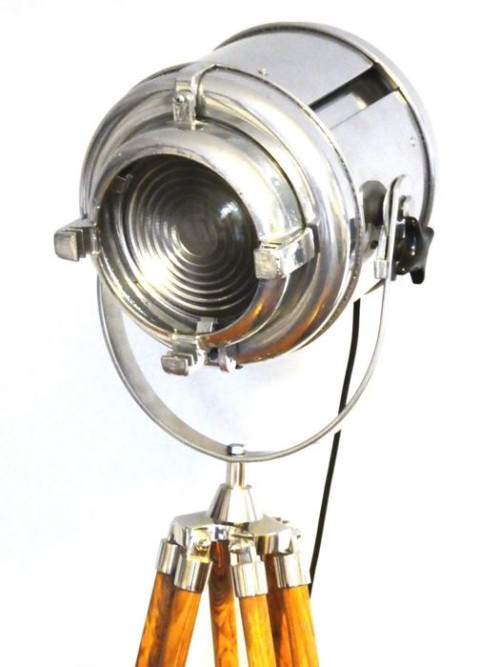
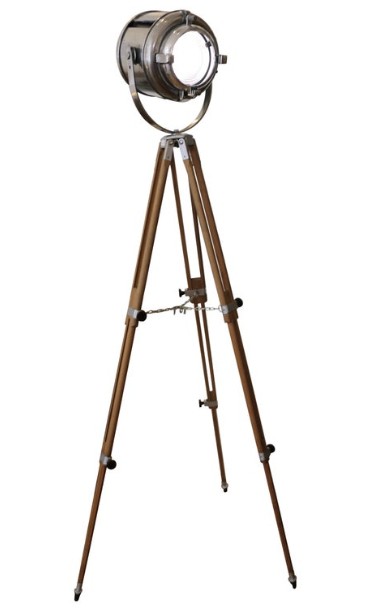 Projecteur de théâtre de la marque Furse sur trépied Projecteur de théâtre fabriqué par Furse ligthing (Nottingham-UK) Fournis sur un trépied en bois réglable Années 50 Ré-électrifié Dimensions : H : 32 cm ; L : 27 cm ; P : 27 cm Les trépieds sont ajustable de 75 cm à 170cm
Projecteur de théâtre de la marque Furse sur trépied Projecteur de théâtre fabriqué par Furse ligthing (Nottingham-UK) Fournis sur un trépied en bois réglable Années 50 Ré-électrifié Dimensions : H : 32 cm ; L : 27 cm ; P : 27 cm Les trépieds sont ajustable de 75 cm à 170cm
Theater projector form the brand Furse, 1950s Theater projector manufactured by Furse lignthing (Nottimgham, UK) Provided on an adjustable wooden tripod 1950s Re-elected Dimensions : L : 12.6 in ; W : 10.63 in ; H : 10.63 in The height range is adjustable from 29.53 in to 66.93 in L : 32 cm ; W : 27 cm ; H : 27 cm The height range is adjustable from 75 cm to 170 cm -
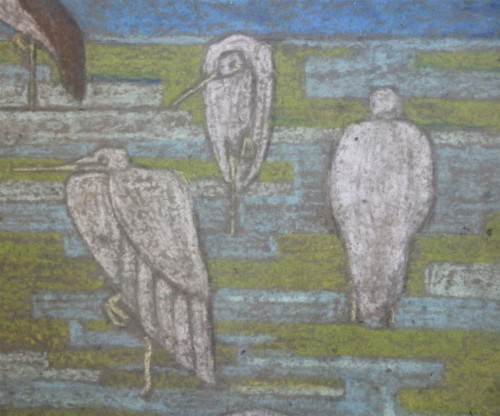
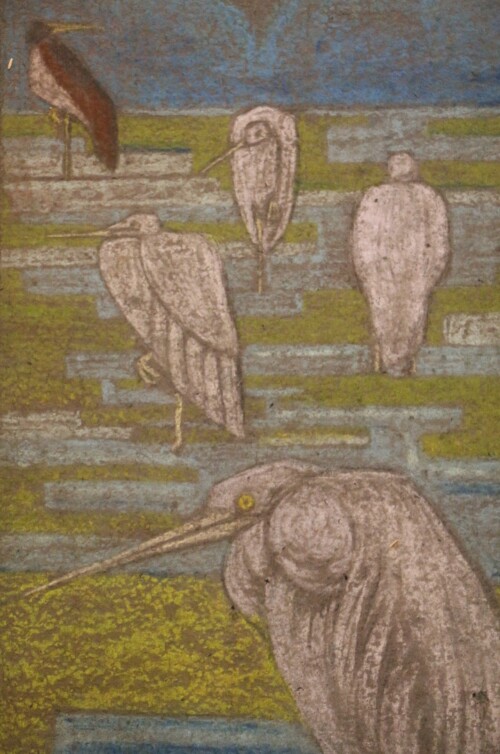
- Pastel sur feutre.
- Papier peint recto-verso.
- Vers 1910-1920.
- Pastel drawing on felt.
- Recto-verso drawing.
- Circa 1920.
-
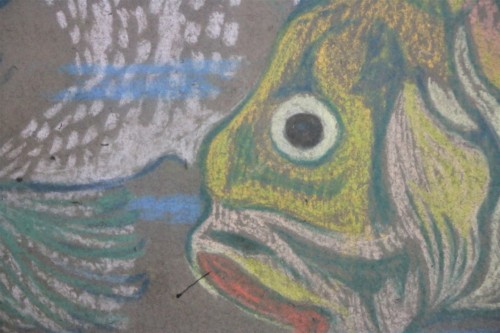
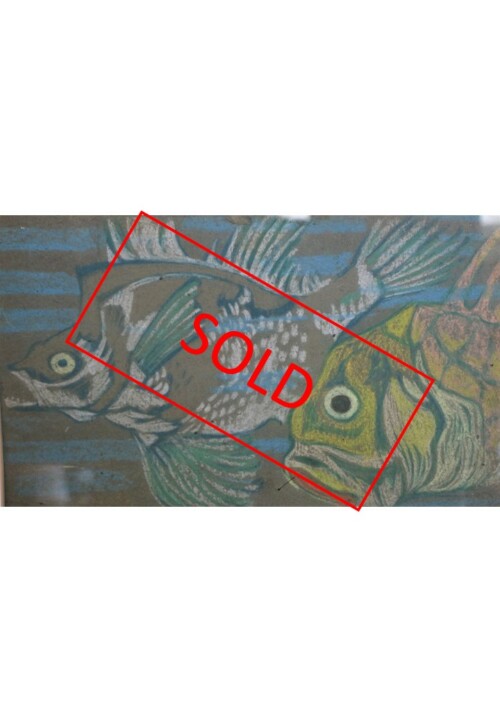 Projet de papier peint - Poissons Pastel sur papier feutre représentant des poissons Période Art Déco (vers 1910-1920) Dimensions : H : 31,4 cm ; L : 50,5 cm (sans cadre) H : 41 ; L : 51 cm (avec cadre)
Projet de papier peint - Poissons Pastel sur papier feutre représentant des poissons Période Art Déco (vers 1910-1920) Dimensions : H : 31,4 cm ; L : 50,5 cm (sans cadre) H : 41 ; L : 51 cm (avec cadre)
Wallpaper design. Pastel drawing on very thick paper representing fish, France, Art Deco. H : 15.75 in. W : 23.62 in. Circa 1920 -
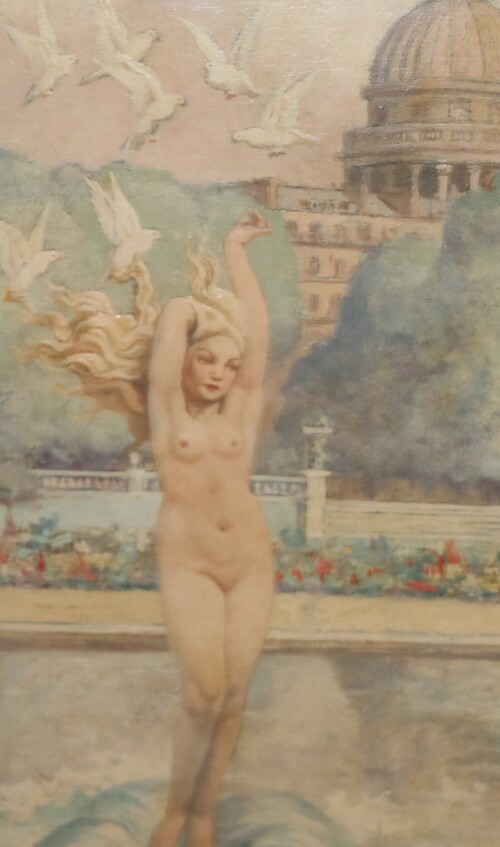
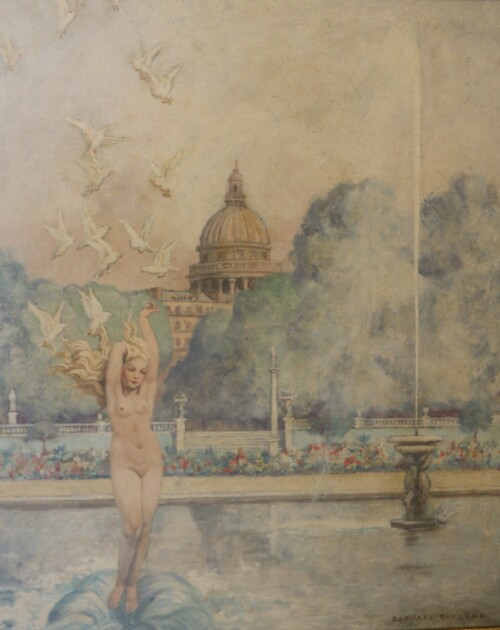 Raphael Delorme (1885-1962) fut l'un des principaux peintres de l'école de peinture bordelaise Art Déco, aux côtés de Dupas, en France dans les années 1920. Ce tableau est typique de son meilleur travail.
Raphael Delorme (1885-1962) fut l'un des principaux peintres de l'école de peinture bordelaise Art Déco, aux côtés de Dupas, en France dans les années 1920. Ce tableau est typique de son meilleur travail.- Signé en bas.
- Accompagné d'un certificat d'authenticité de l'expert Cécile Ritzenthaler.
Raphael Delorme (1885-1962) was one of the leading painter from the Art Deco Bordeaux school of painting with Dupas in France in the 1920's. This painting is typical of his best work.- Signed at the bottom.
- Accompanied by a certificate of authenticity from the expert Cecile Ritzenthaler.
-

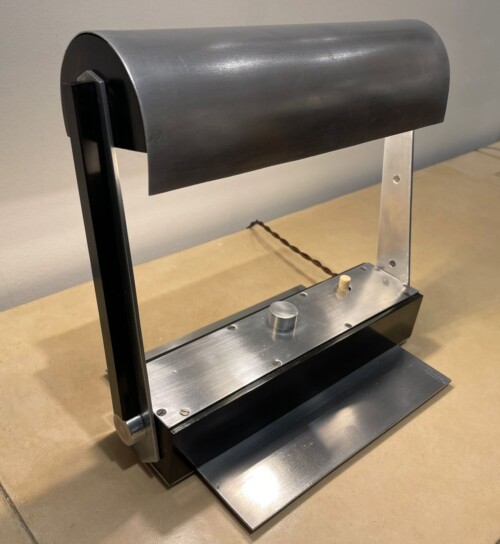 Jacques Le Chevallier (1896-1987) est une figure majeure du modernisme français. Maître verrier, décorateur et illustrateur, formé aux Arts décoratifs, il s’impose dans les années 1920, notamment au Pavillon français de l’Exposition internationale des arts décoratifs de 1925. Tout au long de sa carrière, il développe une approche singulière de la lumière, notamment à travers ses vitraux pour des édifices civils et religieux en Europe, dont Notre-Dame de Paris. Entre 1927 et le début des années 1930, en collaboration avec l’ingénieur René Koechlin (1866 1951), il produit une série limitée de luminaires en matériaux industriels. Ces pièces, au design épuré mêlant fonctionnalité et modernité, sont rapidement abandonnées pour que Le Chevallier se consacre au vitrail. Exceptionnelle lampe moderniste n°58 de Jacques Le Chevallier, fabriquée par son associé et ingénieur René Koechlin. Ce modèle articulé, le seul connu du créateur, illustre l'innovation technique et esthétique de l'époque. Lampe Piano, modèle n°58 Rare lampe de qualité muséale et seul modèle articulé du créateur Probable prototype Aluminium et ébonite Pivots de rotation permettant une inclinaison à 45° de l’ensemble Signée du cartouche de l’artiste : « DÉPOSÉ JLC RK » Provenance : collection privée, restée dans la même famille depuis 1935 Présence de marques d’usage visibles sur les pivots de rotation et le dos (ébonite) 1929 Restauration d’usage réalisée par Raphaël Armand, avec remplacement de pièces et mécanismes par des éléments d’époque. Certificat établi par le restaurateur lui-même, l’un des meilleurs spécialistes de la restauration de luminaires du XXᵉ siècle, intervenu notamment sur le salon Paulin à l’Élysée, la villa Cavrois de Mallet-Stevens et la villa E-1027 d’Eileen Gray. Dimensions H : 29 cm ; L : 32,3 cm ; P : 19 cm Cette lampe est répertoriée dans Jacques Le Chevallier – La Lumière Moderne, pages 96 à 99. _____________________________________________________________________________________________ Jacques Le Chevallier (1896–1987) is a major figure of French modernism. A master glassmaker, decorator, and illustrator, trained at the École nationale des Arts Décoratifs, he gained recognition in the 1920s, notably at the French Pavilion of the 1925 International Exposition of Decorative Arts. Throughout his career, he developed a unique approach to light, especially through his stained glass windows for civil and religious buildings across Europe, including Notre-Dame de Paris. Between 1927 and the early 1930s, in collaboration with engineer René Koechlin (1866–1951), he produced a limited series of lighting fixtures using industrial materials. These pieces, featuring a streamlined design blending functionality and modernity, were soon discontinued as Le Chevallier devoted himself exclusively to stained glass. Exceptional modernist lamp No. 58 by Jacques Le Chevallier (1896–1987), manufactured by his associate and engineer René Koechlin (1866–1951). This articulated model, the only one known from the creator, exemplifies the technical and aesthetic innovation of the period. Piano Lamp, model No. 58 Rare museum-quality lamp, the only articulated model created by the designer Believed to be a prototype Aluminium and ebonite Switch and dimmer allowing a 45° tilt of the entire lamp Signed with the artist’s cartouche: “DÉPOSÉ JLC R K” Provenance: Private collection, remained in the same family since 1935 Signs of wear visible on the rotating pivot and the back (ebonite) Circa 1929 Conservation work carried out by Raphaël Armand, involving the replacement of parts and mechanisms with period-appropriate components. The restoration certificate was issued by R.Armand himself, one of the leading lighting restorers of the 20th century, known for his work on landmark projects such as the Salon Paulin at the Élysée Palace, the Villa Cavrois by Mallet-Stevens, and Eileen Gray’s Villa E-1027. Dimensions H: 29 cm; W: 32.3 cm; D: 19 cm H: 11.4 in; W: 12.7 in; D: 7.5 in This lamp is referenced in Jacques Le Chevallier – La Lumière Moderne, pages 96-99.
Jacques Le Chevallier (1896-1987) est une figure majeure du modernisme français. Maître verrier, décorateur et illustrateur, formé aux Arts décoratifs, il s’impose dans les années 1920, notamment au Pavillon français de l’Exposition internationale des arts décoratifs de 1925. Tout au long de sa carrière, il développe une approche singulière de la lumière, notamment à travers ses vitraux pour des édifices civils et religieux en Europe, dont Notre-Dame de Paris. Entre 1927 et le début des années 1930, en collaboration avec l’ingénieur René Koechlin (1866 1951), il produit une série limitée de luminaires en matériaux industriels. Ces pièces, au design épuré mêlant fonctionnalité et modernité, sont rapidement abandonnées pour que Le Chevallier se consacre au vitrail. Exceptionnelle lampe moderniste n°58 de Jacques Le Chevallier, fabriquée par son associé et ingénieur René Koechlin. Ce modèle articulé, le seul connu du créateur, illustre l'innovation technique et esthétique de l'époque. Lampe Piano, modèle n°58 Rare lampe de qualité muséale et seul modèle articulé du créateur Probable prototype Aluminium et ébonite Pivots de rotation permettant une inclinaison à 45° de l’ensemble Signée du cartouche de l’artiste : « DÉPOSÉ JLC RK » Provenance : collection privée, restée dans la même famille depuis 1935 Présence de marques d’usage visibles sur les pivots de rotation et le dos (ébonite) 1929 Restauration d’usage réalisée par Raphaël Armand, avec remplacement de pièces et mécanismes par des éléments d’époque. Certificat établi par le restaurateur lui-même, l’un des meilleurs spécialistes de la restauration de luminaires du XXᵉ siècle, intervenu notamment sur le salon Paulin à l’Élysée, la villa Cavrois de Mallet-Stevens et la villa E-1027 d’Eileen Gray. Dimensions H : 29 cm ; L : 32,3 cm ; P : 19 cm Cette lampe est répertoriée dans Jacques Le Chevallier – La Lumière Moderne, pages 96 à 99. _____________________________________________________________________________________________ Jacques Le Chevallier (1896–1987) is a major figure of French modernism. A master glassmaker, decorator, and illustrator, trained at the École nationale des Arts Décoratifs, he gained recognition in the 1920s, notably at the French Pavilion of the 1925 International Exposition of Decorative Arts. Throughout his career, he developed a unique approach to light, especially through his stained glass windows for civil and religious buildings across Europe, including Notre-Dame de Paris. Between 1927 and the early 1930s, in collaboration with engineer René Koechlin (1866–1951), he produced a limited series of lighting fixtures using industrial materials. These pieces, featuring a streamlined design blending functionality and modernity, were soon discontinued as Le Chevallier devoted himself exclusively to stained glass. Exceptional modernist lamp No. 58 by Jacques Le Chevallier (1896–1987), manufactured by his associate and engineer René Koechlin (1866–1951). This articulated model, the only one known from the creator, exemplifies the technical and aesthetic innovation of the period. Piano Lamp, model No. 58 Rare museum-quality lamp, the only articulated model created by the designer Believed to be a prototype Aluminium and ebonite Switch and dimmer allowing a 45° tilt of the entire lamp Signed with the artist’s cartouche: “DÉPOSÉ JLC R K” Provenance: Private collection, remained in the same family since 1935 Signs of wear visible on the rotating pivot and the back (ebonite) Circa 1929 Conservation work carried out by Raphaël Armand, involving the replacement of parts and mechanisms with period-appropriate components. The restoration certificate was issued by R.Armand himself, one of the leading lighting restorers of the 20th century, known for his work on landmark projects such as the Salon Paulin at the Élysée Palace, the Villa Cavrois by Mallet-Stevens, and Eileen Gray’s Villa E-1027. Dimensions H: 29 cm; W: 32.3 cm; D: 19 cm H: 11.4 in; W: 12.7 in; D: 7.5 in This lamp is referenced in Jacques Le Chevallier – La Lumière Moderne, pages 96-99. -
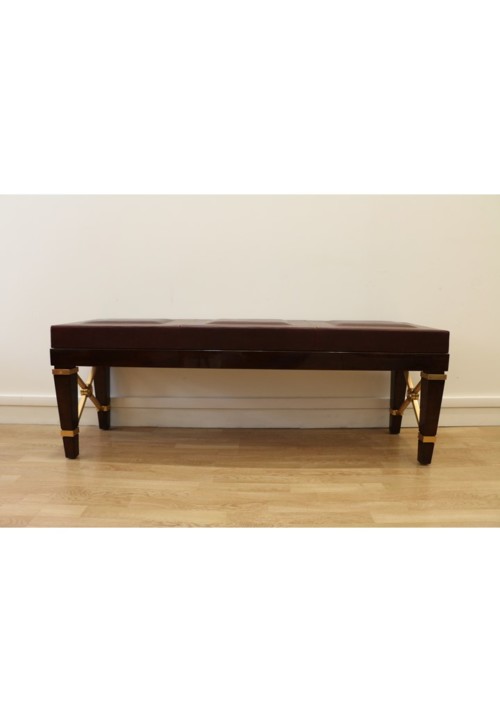
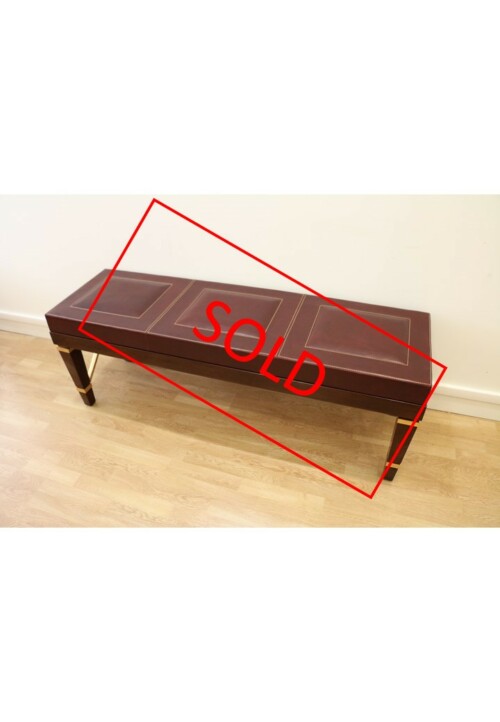 Raymond SUBES (1891-1970) Banquette garnie à neuf d’un cuir brun-rouge à piqûres sellier. Sur pieds gaines en acajou à motifs latéraux croisées en bronze doré. Modèle réalisé pour la Banque de France. La galerie propose deux modèles identiques. Années 1940-1950 Dimensions : H : 54 cm ; L : 150 cm ; P : 45 cm Pour plus d'informations sur le créateur, cliquer sur le nom : Raymond SUBES
Raymond SUBES (1891-1970) Banquette garnie à neuf d’un cuir brun-rouge à piqûres sellier. Sur pieds gaines en acajou à motifs latéraux croisées en bronze doré. Modèle réalisé pour la Banque de France. La galerie propose deux modèles identiques. Années 1940-1950 Dimensions : H : 54 cm ; L : 150 cm ; P : 45 cm Pour plus d'informations sur le créateur, cliquer sur le nom : Raymond SUBES
Bench by Raymond Subes (1891-1970) from the years 1940s-1950s The legs are made of mahogany with lateral X shape gilt bronze design, it is covered with red-brown saddle-stitched leather. It is fully restored (new leather and varnish) and is in perfect condition. This bench was created by R Subes for the Banque de France (French State Bank). The gallery has in stock another identical item. Raymond Subes is one of the major designers of the 1920s to the 1940. He collaborated with many famous architects and artists of his time e.g. steamers decoration and major exhibitions such as the Exposition Internationale des Arts Décoratifs in 1925 which set the Art Deco style on the world stage and the Exposition Universelle de Paris in 1937. His iron work made him famous and he is with Poillerat and Arbus one of the greatest designers of the 1940s style. In 1958 he was elected a member of the French Académie des Beaux-arts.
